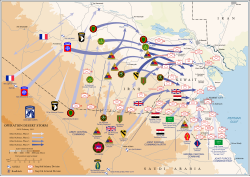User:Clearfrienda/Articles/Drafts/2021/Third-generation warfare
| This is not a Wikipedia article: It is an individual user's work-in-progress page, and may be incomplete and/or unreliable. For guidance on developing this draft, see Wikipedia:So you made a userspace draft. Find sources: Google (books · news · scholar · free images · WP refs) · FENS · JSTOR · TWL |
Third-generation warfare focuses on using Late modern technology-derived tactics of leveraging speed, stealth and surprise to bypass the enemy's lines and collapse their forces from the rear. Essentially, this was the end of linear warfare on a tactical level, with units seeking not simply to meet each other face to face, but to outmaneuver each other to gain the greatest advantage.
It involves tactics of infiltration to bypass and collapse the enemy's combat forces rather than seeking to close with and destroy them; and defence in depth. The 3GW military seeks to bypass the enemy, and attack his rear forward, such as the tactics used by German Stormtroopers in World War I against the British and French in order to break the trench warfare stalemate (Lind 2004). These aspects of 3GW bleed into 4GW as it is also warfare of speed and initiative. However, it targets both military forces and home populations.[1]
| Part of a series on |
| War |
|---|
 |

Description and examples edit
The use of blitzkrieg during the German invasion of France first demonstrated the power of speed and maneuverability over static artillery positions and trench defenses. Through the use of tanks, mechanized infantry, and close air support, the Germans were able to quickly break through linear defenses and capture the rear.
The emphasis on manoeuvring and speed to bypass enemy engagement remains a common strategy throughout the world, and collapsing an enemy's defenses by striking at deeper targets is—in a somewhat different way—a major strategy in fourth generation warfare.[2]
The contributions of the third generation were based on the concept of overcoming technological disadvantage through the use of clever strategy. As linear fighting came to an end, new ways of moving faster began to appear.
The emphasis on mobility moved from heavy armor to greater speed, the development of the helicopter allowed insertions in hostile territory, and advanced missile technology allowed forces to bypass enemy defenses and strike at targets from great distances. The speed inherent in these methods necessitated a greater degree of independence allowed to the units on the front lines.
Greater trust needed to be placed in junior officers commanding sub-units by higher-ranking officers—a belief that they could adequately achieve their objectives without micromanagement from higher ranking commanders in command headquarters.
Smaller units were allowed greater decision flexibility to deal with changing situations on the ground, rather than have decisions made for them by commanders who were distant from the front. This began to break down the regimented culture of order that was so important in previous theoretical eras of military command and control.[3]
Examples edit
References edit
- ^ Lind, William S. (January 15, 2004), "Understanding Fourth Generation War", antiwar.com, retrieved February 7, 2010
- ^ Lind, William S. (January 15, 2004), "Understanding Fourth Generation War", antiwar.com, retrieved February 7, 2010
- ^ Lind, William S.;Nightingale, Keith;Schmitt, John F.; Sutton, Joseph W.;Wilson, Gary I. (1989). The Changing Face of War: Into the Fourth Generation.
{{cite book}}: CS1 maint: multiple names: authors list (link)
Category:20th-century conflicts
Category:Warfare by type
Category:Military doctrines
